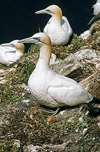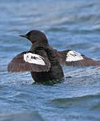
This distinctive dome-shaped island-rock lies 10 miles (16 km) off the coast of South Ayrshire and rises sharply from the Firth of Clyde to a height of 340m (1114 feet).
Ailsa Craig, which comes from the Gaelic for 'Fairy Rock', is 1200m (1300 yards) long and 800m (900 yards) wide, with an area of 100 Ha (245 acres). It is also known as Paddy's Milestone owing to its position as a landmark en route from Ireland.
The island was the heart of an ancient volcano, its rock exhibiting fine columnar structure and was renown as the source of a superior micro-granite used to fashion curling stones.
Indeed, most curling stones still in use today were made from Ailsa Craig granite.
By the late 19th Century the island had a population of 29 people, working in the quarries or the lighthouse, which was built in 1883-6 by Thomas Stevenson and his nephew David.
However, since the closure of the quarries and automation of the light, Ailsa Craig has been inhabited only by a sizeable and important colony of seabirds.
The dramatic seacliffs are home to the third largest gannetry in the UK - comprising 36,000 pairs - with a supporting cast of guillemots, razorbills, black guillemots and increasing numbers of puffins.
It is designated as a Site of Special Scientific Interest and Special Protection Area because it supports 73,000 breeding seabirds.
The island is accessible by boat from Girvan.
Further information:
http://www.rspb.org.uk/reserves/guide/a/ailsacraig/index.aspx
http://www.ailsacraig.org.uk


